|
|
|||
|
Water Test Results
Test results from the new filter May / June 2008:
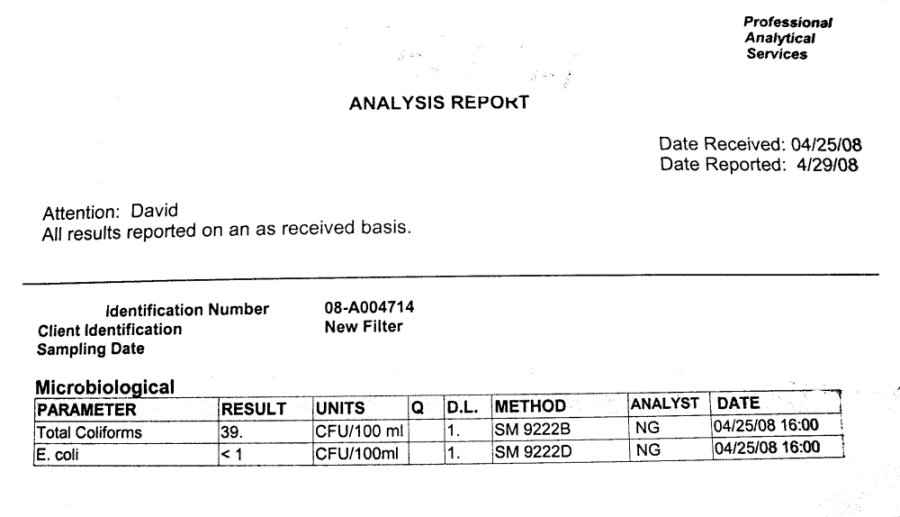
This is the first test in May. The filter has not fully developed the biological layer.
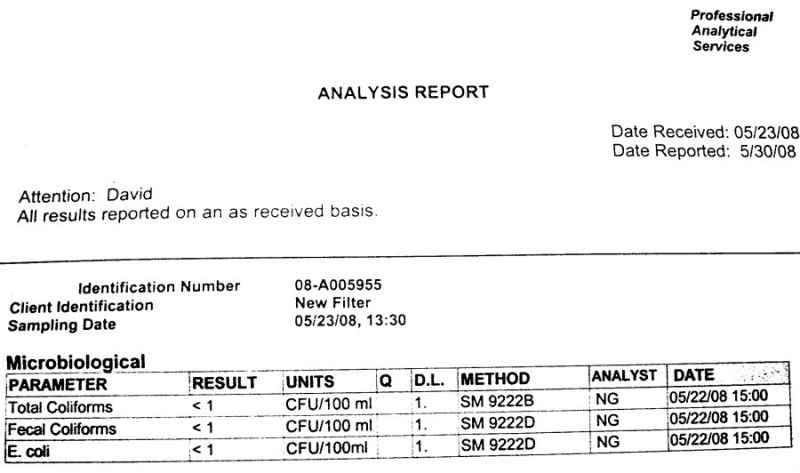
This is the second test received on June 3, 2008. The new filter is now working.
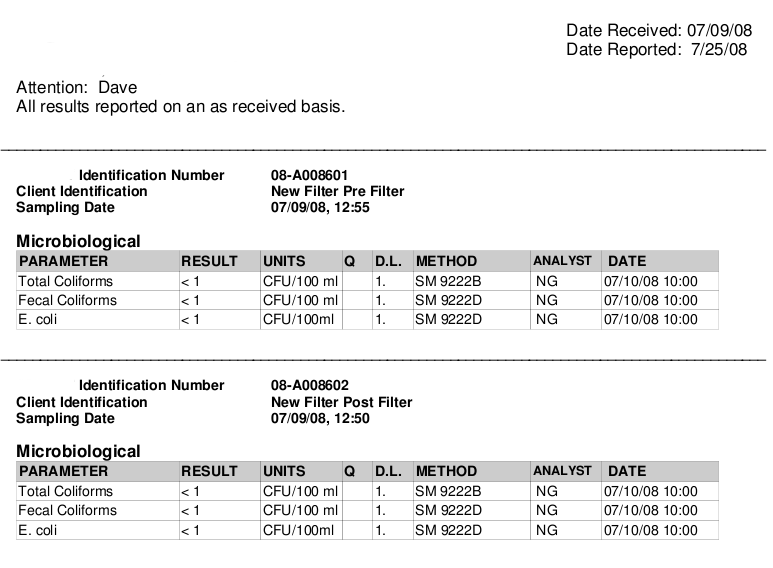
This is the most recent test on the new filter
Below are the test results from the original filter:
Test results from the new filter May / June 2008:

This is the first test in May. The filter has not fully developed the biological layer.

This is the second test received on June 3, 2008. The new filter is now working.

This is the most recent test on the new filter
Below are the test results from the original filter:
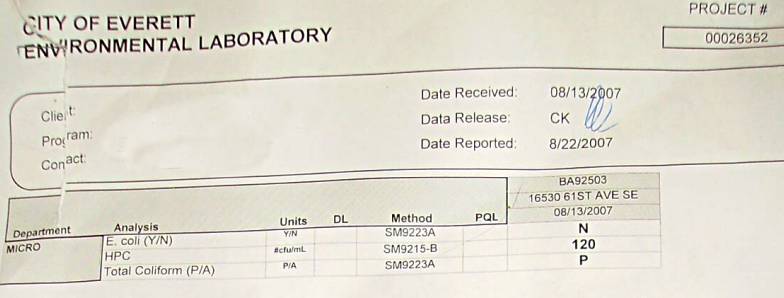 Water Sample test results post-filter August 8 2007. BEFORE the .15mm sand was added. Not using a first-flush diverter on the roof water source. 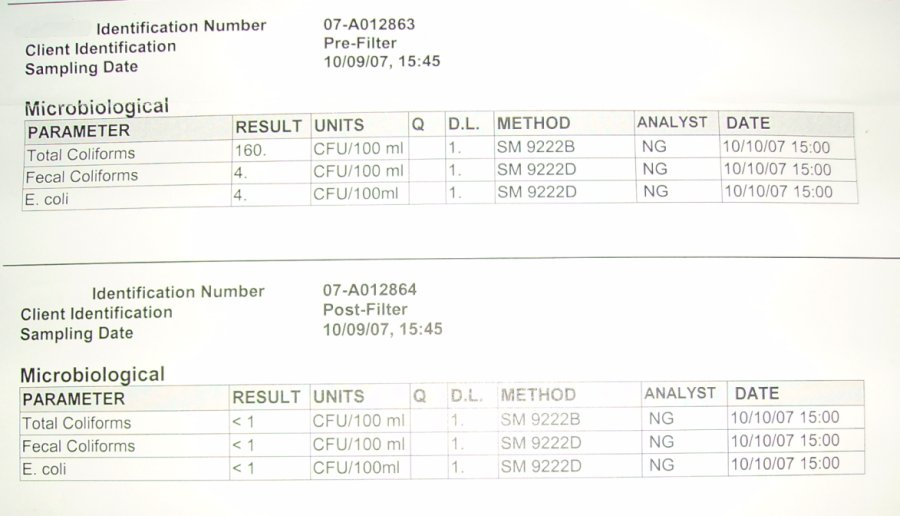 Water sample tests pre-filter and post-filter Oct. 18 2007. AFTER the .15mm sand was added. Not using a first flush diverter on the roof water source. 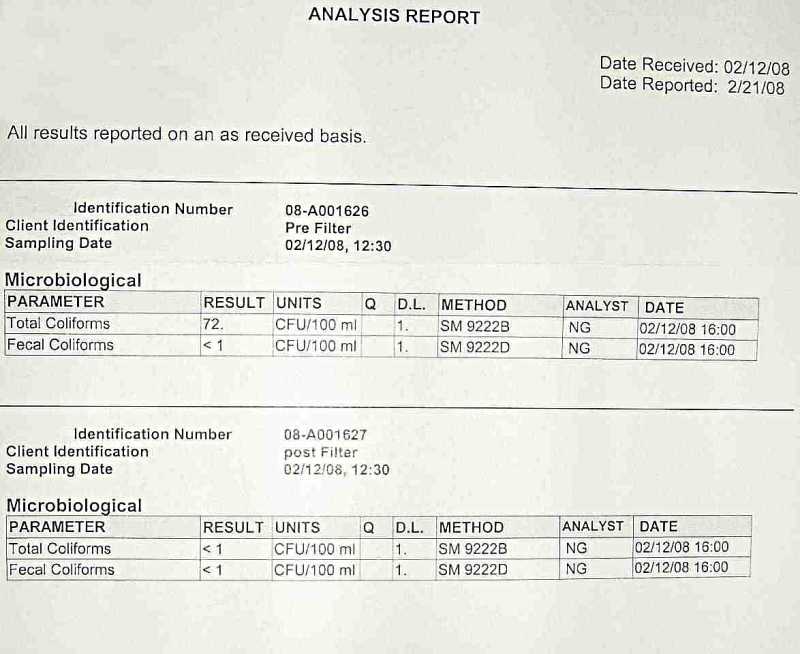 Water sample tests pre-filter and post-filter for Feb 2008. AFTER the .15mm sand was added. Using a first-flush diverter on the roof water source, and the recirculating pump system wherein raw water is added once a day in amounts less than 5 gallons, with as many as 3 consecutive days where no raw water is added and temperatures are at or below freezing (32 degrees F) 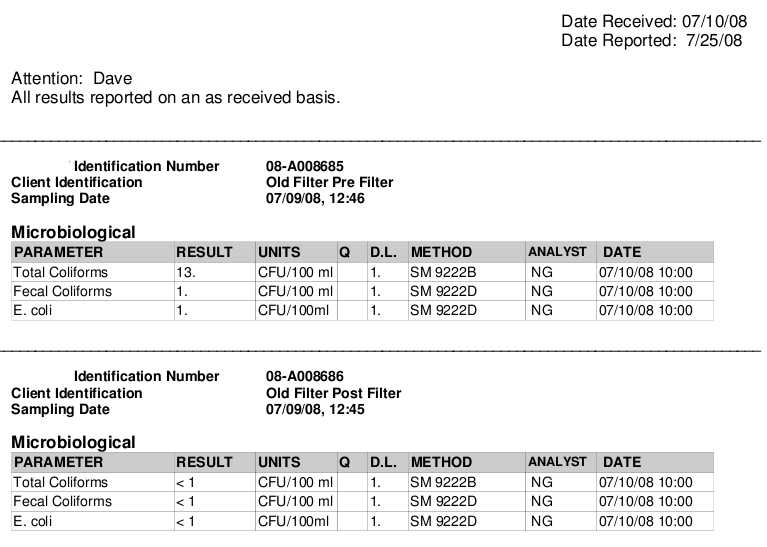 This is another test on the old filter Below are the most recent tests on the old filter: 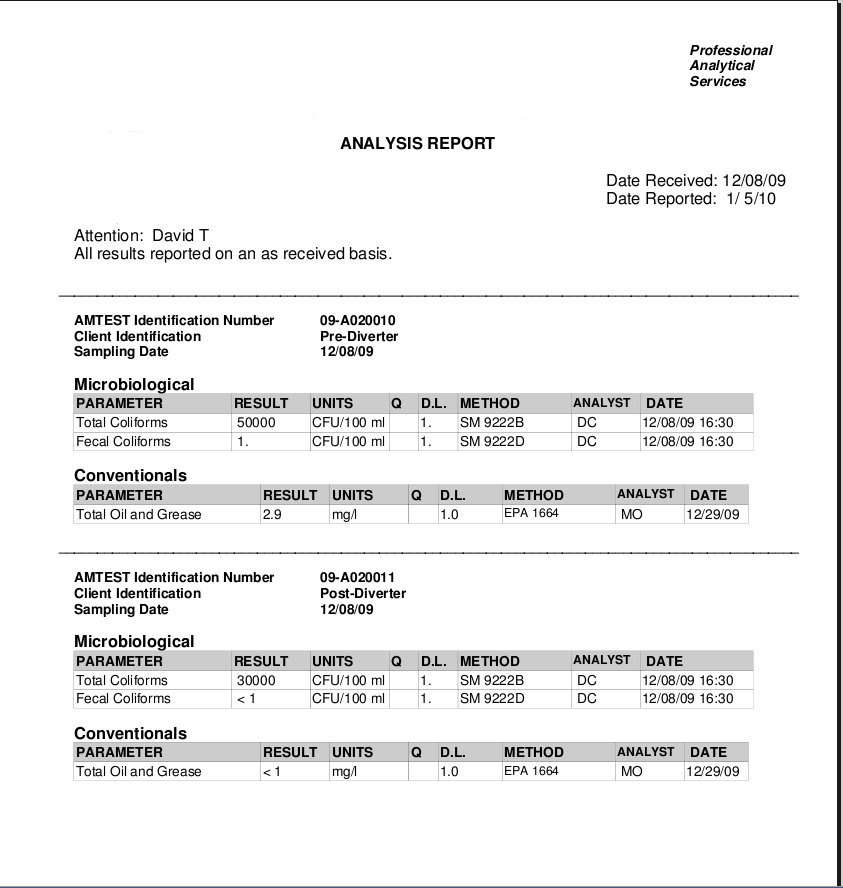 Water sample tests pre-diverter and post-diverter for Jan 2010. This shows considerable removal of petroleum hydorcarbons (TPH Total Petroleum Hydrocarbons). 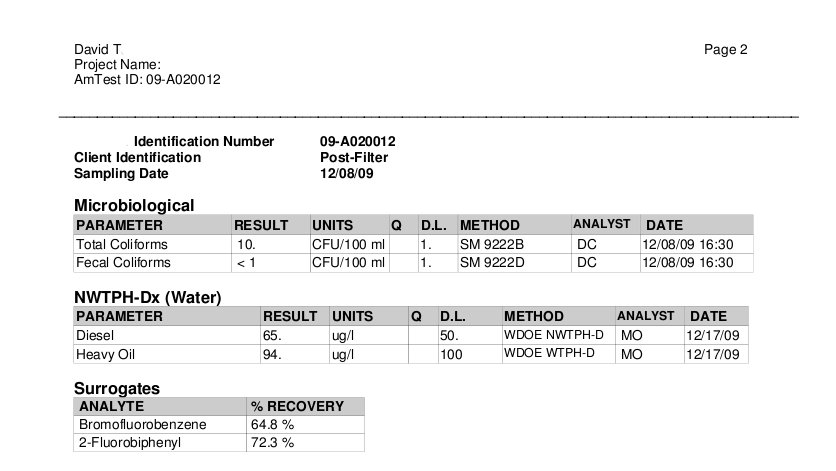 This is the most recent test on the filter. Note the removal of coliform bacteria and petroleum hydrocarbons (TPH) So far, what conclusions can we draw from all of the test results? Most importanly THESE TESTS DO NOT SHOW THAT THE WATER FROM THESE FILTERS IS SAFE TO DRINK. Only E Coli, Fecal coliform, and coliform bacteria have been shown to be removed by these filters in this situation. Other biological components could be present in the water and the only way to determine what is present would be to do a very expensive test for all possible biological contaminants. Also, total petroleum hydrocarbons are significantly reduced, however any other non-biological contaminants could be present in the water. Water from different areas will contain different substances. You have been advised. 1.The tests show all coliform bacteria are removed: E Coli, Fecal coliform, and coliform in the filter design with .15mm sand added. 2. The addition of the first flush diverter and/or the cold weather, or a combination of cold weather, more water, and the diverter have (apparently?) reduced (but not eliminated) the amount of coliform bacteria in the water taken from this roof. 3. The biological activity of the filter does not completely stop in weather at near freezing temperatures; and after several days of inactivity while frozen, the functionality of this filter was not adversely effected. 4. A first flush diverter will not safely remove all bacteria from water taken from this roof. 5. Near freezing temperatures will not eliminate all coliform bacteria from the water taken from this roof. 6. It is not safe to consume unfiltered/unpurified water taken from this roof even though there is a diverter in the system. 7. From a bacteriological standpoint, the water from this slow sand filter is safe to consume in summer temperatures, fall temperatures and winter temperatures in this area - providing the filter is properly operated and maintained. 8. We do not know the nature of chemical pollution of the water from this filter. 9. With respect to chemical pollution, more filtering/testing would be necessary to confirm that the water from this filter / supply system is safe to consume over long periods of time. 10. We regard to health, it is prudent to err on the side of caution and assume that water from a roof is not safe to drink without filtering and testing. 11.We do not know from the tests what viruses are present or not present in the post-filter water. 12.Since coliform bacteria are removed, viruses called "Phages" or "Bacteriophages" that occupy coliform may also removed; but we do not know for sure. 13.Since the test for pathogens did not specifically include tests for all viruses; if the water is to be used on a regular basis for drinking, the use of a uv filter is highly recommended. 14.Coarse sand is not as effective as fine sand in the removal of bacteria. 15. The tests show that Total Petroleum Hydrocarbons (TPH) are significantly reduced. History of testing: Monday 2007-08-13: An EPA certified testing lab will be checking the water for Ecoli and Coliform; and they will do a Heterotrophic Plate count. Tuesday, 2007-08-14: One part of the test has come back - and it has been confirmed that as far as bacterial content, the water from the roof used to test the filter is safe for irrigation of a vegetable garden after it has been run through the filter; however it is not yet confirmed safe for drinking. I have not yet recieved the documentation as to the results of the E Coli test. Friday, 2007-08-22. Have received the documented test results. No E Coli were found in the samples. The heterotrophic plate count was 120; and there were coliform bacteria found, but no enumeration was done. Just P/A (presence or absence). Most coliform bacteria (with the exception of E Coli are harmless and always present in water); so a P/A test only determines the possiblility of E Coli contamination.2 What does this mean? The answer is not simple. First of all, the water came from the roof through gutters and downspouts before their yearly cleaning. This runoff was most certainly full of E Coli from birds, racoons, squirrels, bats, and most other wildlife found in a forest (the roof is in a forest with tree limbs overhanging all around)3. 75.1.162.124 So you see, the filter obviously removed lots of bad stuff. This is not very scientific however, because I did not have the water tested before it went into the filter. . . take one look at the water from the roof, and I dare you to drink it! Nasty stuff. To test water for all possible contaminates would be impractical. The filter cleaned it up and took out any E Coli that was there. So what if there was no E Coli in the water in the first place? Yes, that is a possibility. . .. Now, what about "Beaver fever", and other types of cysts? The water that comes out of the filter is non-turbid enough to run through a UV filter which will inactivate everything, and a 1 micron water filter, will remove cysts, but not E Coli - but you cannot use either of these with turbid water. At the least, the filter is the first and most essential element of a clean-water supply system. At best, the filter provides safe water with no other processing involved. More later. . . 10/18/07. The test results on the smaller sand size modified filter output have come back. This time a test was done on the water before it went into the filter and a test was done on the water after it had gone through the filter. The water that was "pre-filter" was collected from the roof with no first flush diverter installed so that as much bacteria as possible would be in the water. This water was nasty looking and, as shown by the test results, also contained harmful bacteria. The water from the roof that was used as "pre filter" water came from 200 gallons of storage. The quantity of this water to be tested was put into the filter and allowed to run through the filter before a sample was taken for "post filter" testing. This assured that the water being tested was actually part of the contaminated "pre filter" water with the action of the filter on it complete. This filter removed coliforms, E. coli and fecal coliforms from 160, 4 and 4 per 100ml respectively; to less than 1 in 100 ml for each. This meets the state of New York's standards. Less than 1 per 100 ml is the way many labs express the "absence" part the "presence/absence" notation. In other words no E. Coli were found in the sample. That is not to say that there could not be one E. Coli in several thousands of gallons of water; but in that concentration they would be harmless. The fact is that the water from this filter design is quite safe. 02/12/08. Another test went in today. This is after the filter has been through 2 weeks of sub-freezing weather, the flow stopped and it was not possible to run water through the filter for 3 consecutive days during the cold weather. With the exception of the 3 days of freezing temperatures, filtered water has been continuously circulated through the filter at a rate of 2 gallons per hour prior to and after the freeze. This is done with a small dc pump (which can be run from a solar panel). As raw water becomes available it has been added once a day. The water collection system now has a first flush diverter installed. The filter has been operated at the outside margin of its recommended operating parameters to test the operation to the utmost. A favorable outcome from the tests is not expected. . . but they will be back in about a week. I will post the results as they become available. 02/26/08: The test results are back. No coliform or fecal coliform were found in the water coming from the filter (post filter). Seventy one (71) coliform per 100 ml were in the raw water from the roof (pre filter). |
|||
| back |
|
|

This work is licensed under a Creative Commons Attribution-ShareAlike 2.5 License. terms of use
